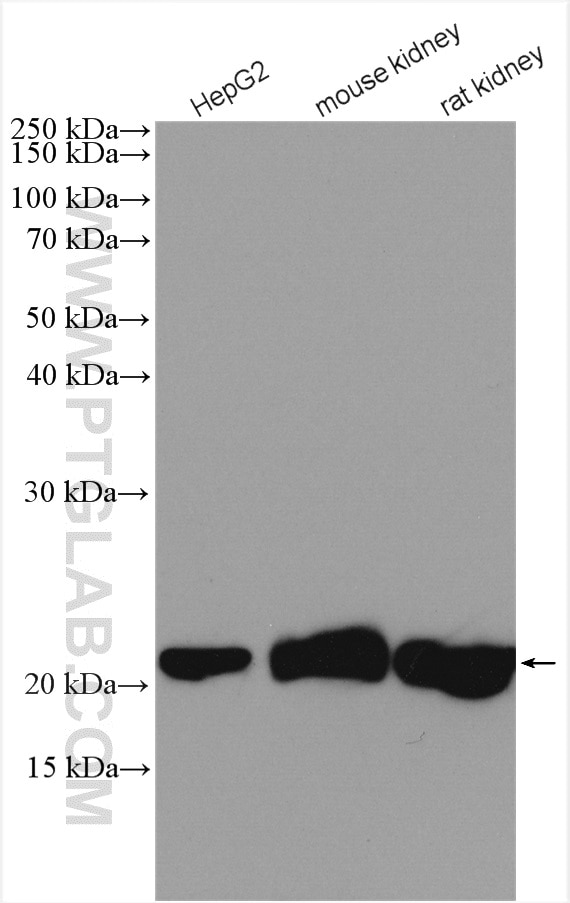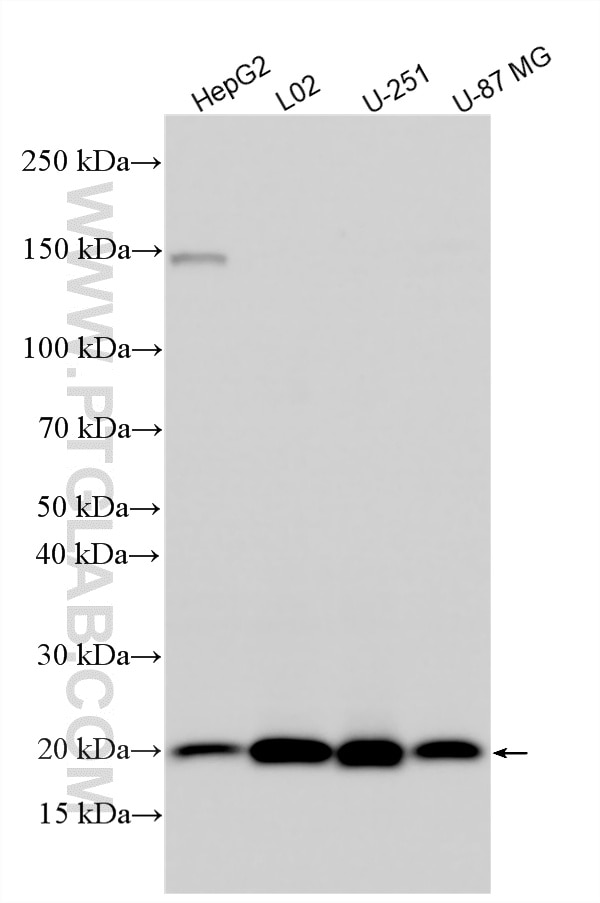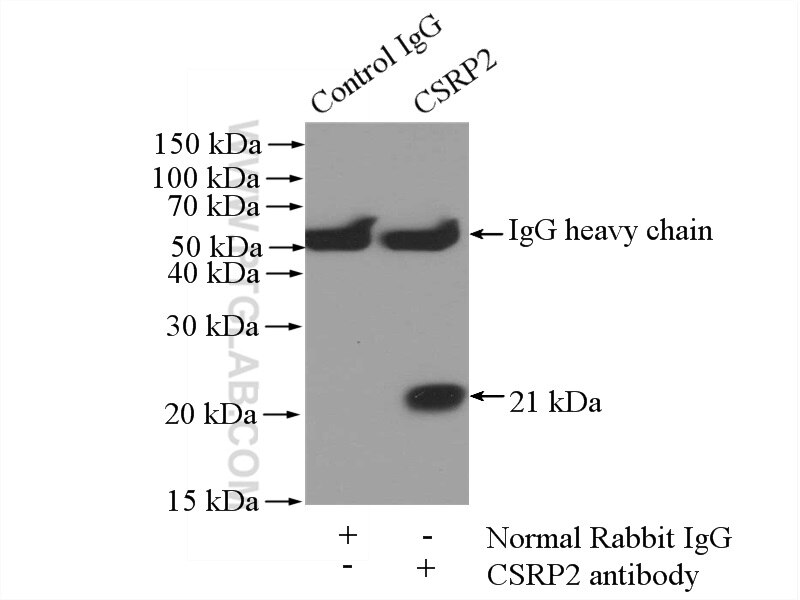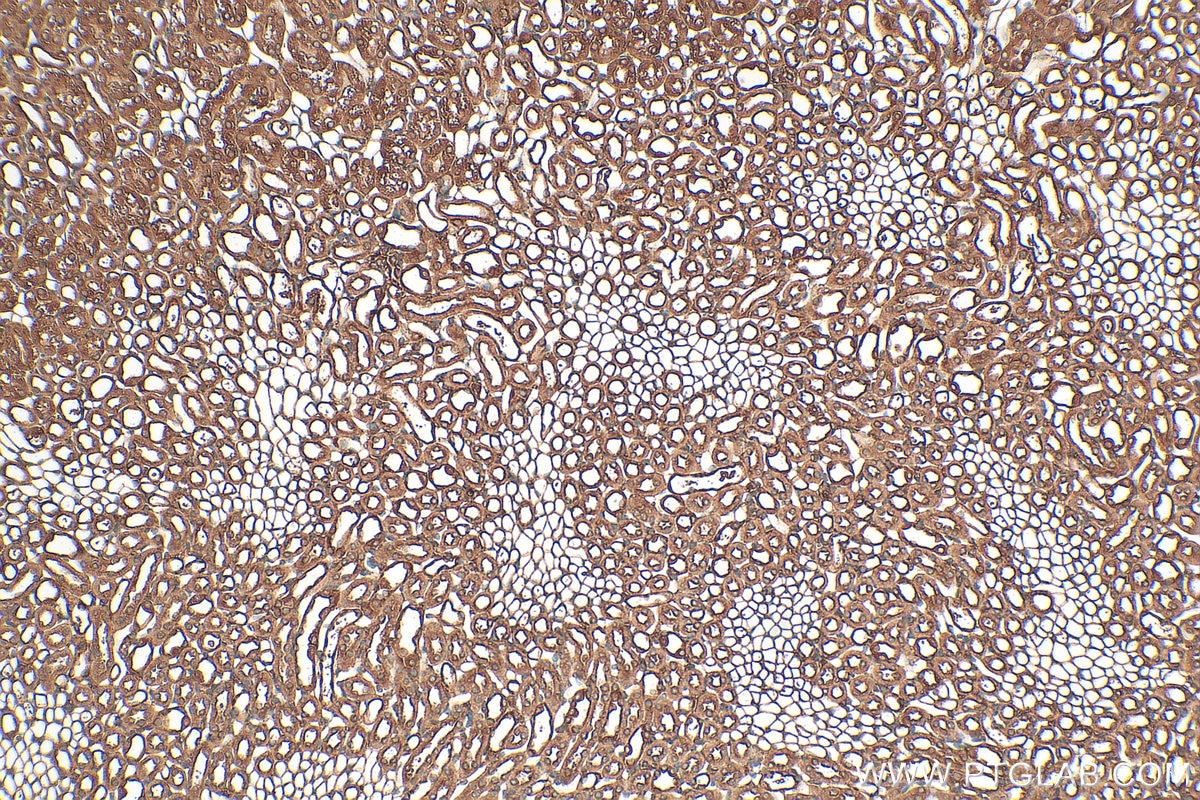Tested Applications
| Positive WB detected in | HepG2 cells, mouse kidney tissue, rat kidney tissue, L02 cells, U-251 cells, U-87 MG cells |
| Positive IP detected in | mouse liver tissue |
| Positive IHC detected in | mouse kidney tissue Note: suggested antigen retrieval with TE buffer pH 9.0; (*) Alternatively, antigen retrieval may be performed with citrate buffer pH 6.0 |
Recommended dilution
| Application | Dilution |
|---|---|
| Western Blot (WB) | WB : 1:1000-1:10000 |
| Immunoprecipitation (IP) | IP : 0.5-4.0 ug for 1.0-3.0 mg of total protein lysate |
| Immunohistochemistry (IHC) | IHC : 1:50-1:500 |
| It is recommended that this reagent should be titrated in each testing system to obtain optimal results. | |
| Sample-dependent, Check data in validation data gallery. | |
Published Applications
| KD/KO | See 4 publications below |
| WB | See 7 publications below |
| IHC | See 4 publications below |
| IF | See 3 publications below |
| IP | See 1 publications below |
| CoIP | See 2 publications below |
Product Information
10892-2-AP targets CSRP2 in WB, IHC, IF, IP, CoIP, ELISA applications and shows reactivity with human, mouse, rat samples.
| Tested Reactivity | human, mouse, rat |
| Cited Reactivity | human, mouse, rat |
| Host / Isotype | Rabbit / IgG |
| Class | Polyclonal |
| Type | Antibody |
| Immunogen |
CatNo: Ag1338 Product name: Recombinant human CSRP2 protein Source: e coli.-derived, PGEX-4T Tag: GST Domain: 1-193 aa of BC000992 Sequence: MPVWGGGNKCGACGRTVYHAEEVQCDGRSFHRCCFLCMVCRKNLDSTTVAIHDEEIYCKSCYGKKYGPKGYGYGQGAGTLNMDRGERLGIKPESVQPHRPTTNPNTSKFAQKYGGAEKCSRCGDSVYAAEKIIGAGKPWHKNCFRCAKCGKSLESTTLTEKEGEIYCKGCYAKNFGPKGFGYGQGAGALVHAQ Predict reactive species |
| Full Name | cysteine and glycine-rich protein 2 |
| Calculated Molecular Weight | 21 kDa |
| Observed Molecular Weight | 21 kDa |
| GenBank Accession Number | BC000992 |
| Gene Symbol | CSRP2 |
| Gene ID (NCBI) | 1466 |
| RRID | AB_2087738 |
| Conjugate | Unconjugated |
| Form | Liquid |
| Purification Method | Antigen affinity purification |
| UNIPROT ID | Q16527 |
| Storage Buffer | PBS with 0.02% sodium azide and 50% glycerol, pH 7.3. |
| Storage Conditions | Store at -20°C. Stable for one year after shipment. Aliquoting is unnecessary for -20oC storage. 20ul sizes contain 0.1% BSA. |
Background Information
CSRP2 (Cysteine and glycine-rich protein 2) is a member of the LIM-only family of cysteine-rich proteins and contains two LIM domains, which has been recently implicated in the progression and metastasis of a variety of cancers. CSRP2 is functionally linked to the activity of TGF-b1 in hepatic stellate cells (HSC), derivatives thereof, and in differentiated VSMC.CSRP2 knockdown signifcantly inhibits hypoxia-stimulated invadopodium formation, ECM degradation and invasion in MDA-MB-231 cells (PMID: 33042270). CSRP2 is a short (21 kDa) two LIM domain-containing protein, which is upregulated in invasive breast cancer cells, and localizes along the protrusive actin core of invadopodium1 (PMID: 29976963, 16735029).
Protocols
| Product Specific Protocols | |
|---|---|
| IP protocol for CSRP2 antibody 10892-2-AP | Download protocol |
| WB protocol for CSRP2 antibody 10892-2-AP | Download protocol |
| Standard Protocols | |
|---|---|
| Click here to view our Standard Protocols |
Publications
| Species | Application | Title |
|---|---|---|
Sci Rep Proteotoxicity in cardiac amyloidosis: amyloidogenic light chains affect the levels of intracellular proteins in human heart cells. | ||
Toxicol Appl Pharmacol Cysteine and glycine rich protein 2 exacerbates vascular fibrosis in pulmonary hypertension through the nuclear translocation of yes-associated protein and transcriptional coactivator with PDZ-binding motif
| ||
Cell Biochem Funct Cysteine and glycine-rich protein 2 retards platelet-derived growth factor-BB-evoked phenotypic transition of airway smooth muscle cells by decreasing YAP/TAZ activity
| ||
Toxicol Appl Pharmacol Cysteine and glycine-rich protein 2 is crucial for maintaining the malignant phenotypes of gliomas through its action on Notch signalling cascade | ||
Oncol Rep Cysteine‑ and glycine‑rich protein 2: A vital regulator that inhibits necroptosis glioma cell by activating the JAK‑STAT1 pathways
|










